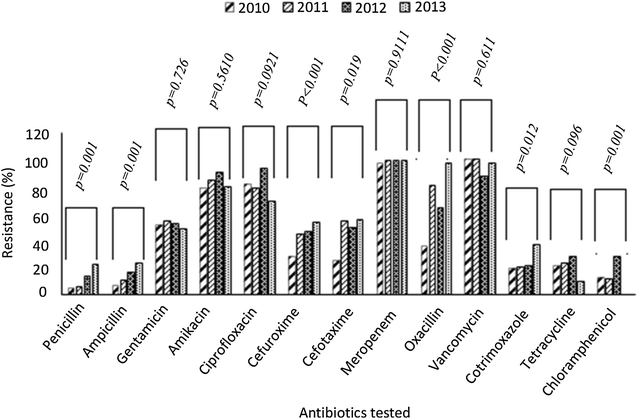Trends in paediatric and adult bloodstream infections at a Ghanaian referral hospital: a retrospective study
- PMID: 27539221
- PMCID: PMC4991019
- DOI: 10.1186/s12941-016-0163-z
Trends in paediatric and adult bloodstream infections at a Ghanaian referral hospital: a retrospective study
Abstract
Background: Bloodstream infections (BSI) are life-threatening emergencies. Identification of the common pathogens and their susceptibility patterns is necessary for timely empirical intervention.
Methods: We conducted a 4-year retrospective analysis of blood cultures from all patients excluding neonates at the Korle-Bu Teaching hospital, Ghana, from January 2010 through December 2013. Laboratory report data were used to determine BSI, blood culture contamination, pathogen profile, and antimicrobial resistance patterns.
Results: Overall, 3633 (23.16 %) out of 15,683 blood cultures were positive for various organisms. Pathogen-positive cultures accounted for 1451 (9.3 %, 95 % CI 8.5-9.8 %). Infants recorded the highest true blood culture positivity (20.9 %, n = 226/1083), followed by the elderly (13.3 %, n = 80/601), children (8.9 %, n = 708/8000) and adults (7.2 %, n = 437/6000) (p = 0.001 for Marascuilo's post hoc). Overall occurrence of BSI declined with increasing age-group (p = 0.001) but the type of isolates did not vary with age except for Citrobacter, Escherichia coli, Klebsiella, Salmonella, and Enterococcus species. Gram negative bacteria predominated in our study (59.8 %, n = 867/1451), but the commonest bacterial isolate was Staphylococcus aureus (21.9 %, n = 318/1451)-and this trend run through the various age-groups. From 2010 to 2013, we observed a significant trend of yearly increase in the frequency of BSI caused by cephalosporin-resistant enterobacteria (Chi square for trend, p = 0.001). Meropenem maintained high susceptibility among all Gram-negative organisms ranging from 96 to 100 %. Among Staphylococcus aureus, susceptibility to cloxacillin was 76.6 %.
Conclusion: Our study shows a significantly high blood culture positivity in infants as compared to children, adults and the elderly. There was a preponderance of S. aureus and Gram-negative bacteria across all age-groups. Meropenem was the most active antibiotic for Gram-negative bacteria. Cloxacillin remains a very useful anti-staphylococcal agent.
Keywords: Adults; Antibiotic susceptibility; Bloodstream; Ghana; Infants; Infections.
Figures



References
MeSH terms
Substances
LinkOut - more resources
Full Text Sources
Other Literature Sources

